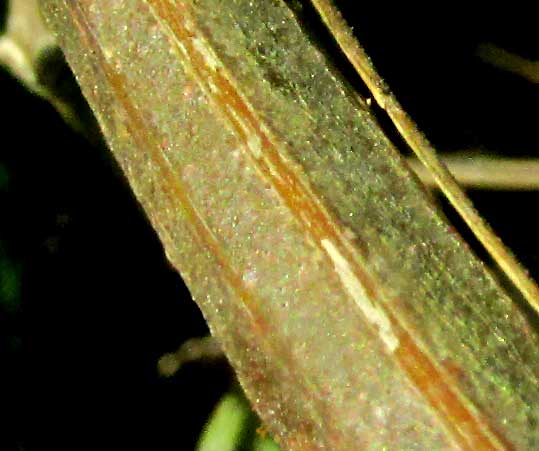Excerpts from Jim Conrad's
Naturalist Newsletter
from the May 23, 2010 Newsletter issued from Hacienda Chichen Resort beside Chichén Itzá Ruins, central Yucatán, MÉXICO
MONKEY-COMBS FLOWERING
Passing across the lawn suddenly numerous whitish-yellow, two-inch long (5 cm), Dutchman's-pipe-like corollas began prettily littering the fast-greening grass. You can see how thickly they'd fallen below:

Picking up a corolla and splitting it longitudinally, the flower's four stamens and corolla shape made clear that this was a member of the Trumpet-Creeper Family, the Bignoniaceae. The corolla-half is below:

That picture tells a story. A pollinator lands on the corolla's flaring lower lip, enters the tube, its back dusted with pollen from other flowers scrapes against the roundish stigma at the tube's ceiling, thus pollinating the blossom. As the pollinator continues down the tube to nectar polled in those little flaps at the base, anthers also held near the ceiling dump pollen onto the back to be carried to the next flower. The anthers look more decomposed than the style and stigma, so I'm guessing that first the anthers matured and released their pollen, then when they were empty the stigma matured, thus keeping the flower from self-pollinating. Just a guess.
Sixteen or so mostly vine members of the Bignonia Family have been listed for the Yucatan, so which was this? In the first picture there was an important clue. Did you notice that brownish, black-stubbled thing lying among the flowers? That's a fruiting pod-half and we've run into such a thing before. Back in Querétaro we met the Monkey-Comb, PITHECOCTENIUM CRUCIGERUM, so called because the brown pods so bristled with short, stiff tubercles that you could comb your hair with them. (see next entry)
So, Monkey-Comb occurs here, too. The plant producing them is a woody vine, or liana, that climbed so high into a Cedro tree above the dropped flowers that really I couldn't see them with my naked eyes. I focused my camera at a cluster of leaves at the tree's crown, where I suspected the flowers to have fallen from, and you can see what developed from that effort below:
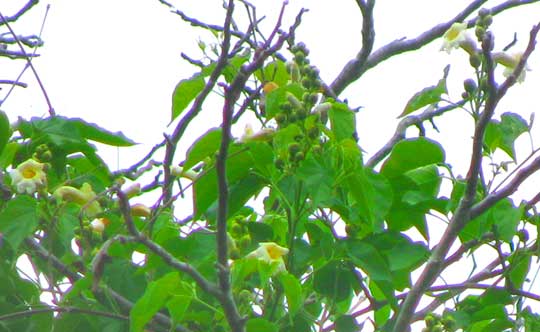
After publishing the Querétaro piece an ecologist in Australia wrote saying that this was an invasive weed over there. So here's a plant native to the American tropics that's gone wild in other parts of the world, where away from its natural enemies that keep it under control here it's displacing native flora.
from the March 24, 2007 Newsletter issued from Sierra Gorda Biosphere Reserve, QUERÉTARO, MÉXICO
MONKEY-COMBS DROPPING BUTTERFLY-SEEDS
A common woody vine climbing into trees all along the road around the reservoir these days is producing a crop of eye-catching fruits. The fruits are brown, elliptic, about hand-size, flattish and -- most striking -- absolutely burry with short, blunt projections. These tubercles are responsible for the vine's name of Monkey-comb, PITHECOCTENIUM CRUCIGERUM. It's a member of the Bignonia Family, the family to which the northern Trumpet Creeper and Crossvine also belong. You can see two spiky, dangling monkey combs below:
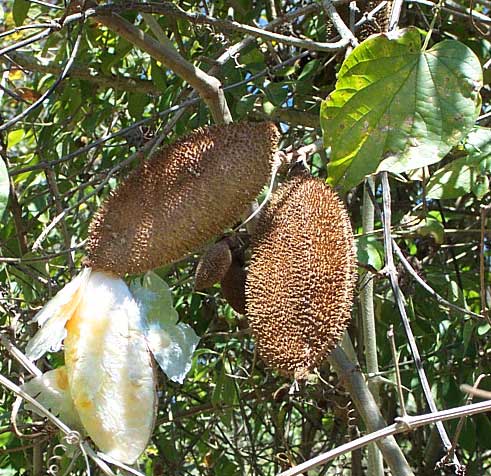
In that picture the fruit on the left has split so that a mass of silvery, waferlike seeds has slipped from the spiny husk. Usually the seeds drop one or two at a time but a bird or something must have jarred this fruit, causing its contents to plop out all at once.
Monkey-comb seeds with their cellophane-like, silvery wings lying on the ground are even more noticeable than the fruits hanging on their vines. Below, you can see three seeds in the palm of my hand.
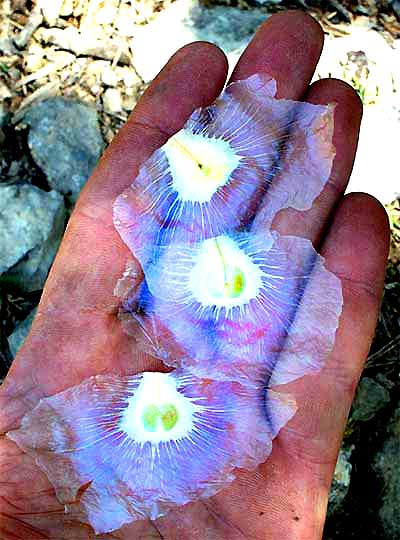
Actually, what you see there is six seeds. The bottom item shows how each butterfly-like thing consists of two seeds with their wings grown together. Of course the wings help the seeds disperse on breezes.
A Spanish name for the vine is Palomitas, which means "Little Doves," and I suppose that the silvery seeds fluttering to the ground could be little doves landing. I think in this area the more common name is Mariposa, meaning butterfly. Back in the Yucatan it has a good Maya name, X-ne-tolok.
The English name Monkey-comb is based on its genus name, Pithecoctenium. In that word you might recognize "pitheco," which also appears in Australopithecus, the name of a group of extinct hominids closely related to humans. Australopithecus means "southern ape." Both "pitheco-" and "pithecus" derive from the Greek "pithekos," for ape. "Ctenium" comes from the Greek "ctenidum," for "comb." Monkey-comb.
Monkey-comb also is a far-ranging species, distributed from Mexico to Brazil.
In Mexico, at least traditionally, there's a pretty use of the butterfly-like seeds as a headache remedy. Just apply a seed to your forehead and the headache is supposed to go away. I bet that the usage is based on the subliminal notion that anything as transparent, light and ethereal as these seeds can't but help a dull, dark, throbbing headache.
issued June 18, 2020 from Tepakán, Yucatán, MÉXICO
MORE PICTURES
Here some flowering vines are within reach, so I have more pictures. First, another flower and leaf picture:

Some leaves bear only two leaflets, but most have three, as shown below:
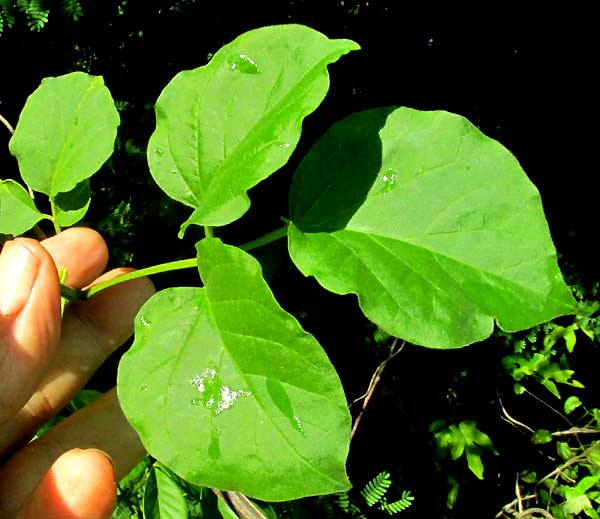
Tendrils are branched as shown below:

And the stem is sharply squared in cross-section:
